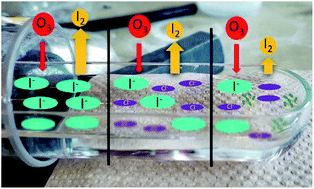Iodine emission from the reactive uptake of ozone to simulated seawater†
Abstract
The heterogeneous reaction of ozone and iodide is both an important source of atmospheric iodine and dry deposition pathway of ozone in marine environments. While the iodine generated from this reaction is primarily in the form of HOI and I2, there is also evidence of volatile organoiodide compound emissions in the presence of organics without biological activity occuring [M. Martino, G. P. Mills, J. Woeltjen and P. S. Liss, A new source of volatile organoiodine compounds in surface seawater, Geophys. Res. Lett., 2009, 36, L01609, L. Tinel, T. J. Adams, L. D. J. Hollis, A. J. M. Bridger, R. J. Chance, M. W. Ward, S. M. Ball and L. J. Carpenter, Influence of the Sea Surface Microlayer on Oceanic Iodine Emissions, Environ. Sci. Technol., 2020, 54, 13228–13237]. In this study, we evaluate our fundamental understanding of the ozonolysis of iodide which leads to gas-phase iodine emissions. To do this, we compare experimental measurements of ozone-driven gas-phase I2 formation in a flow tube to predictions made with the kinetic multilayer model for surface and bulk chemistry (KM-SUB). The KM-SUB model uses literature rate coefficients used in current atmospheric chemistry models to predict I2(g) formation in pH-buffered solutions of marine composition containing chloride, bromide, and iodide compared to solutions containing only iodide. Experimentally, I2(g) formation was found to be suppressed in solutions containing seawater levels of chloride compared to solutions containing only iodide, but the model does not predict this effect using literature rate constants. However, the model is able to predict this trend upon adjustment of two specific reaction rate constants. To more closely represent true oceanic conditions, we add an organic component to the proxy seawater solutions using material generated from Thalassiosira pseudonana phytoplankton cultures. Whereas the rate of ozone deposition is unaffected, the formation rate of I2(g) is strongly suppressed in the presence of biological organic material, indicative of a sink or reduction of reactive iodine formed during the oxidation process.

- This article is part of the themed collections: Atmospheric chemistry and Chemistry of Atmospheric Pollutants


 Please wait while we load your content...
Please wait while we load your content...